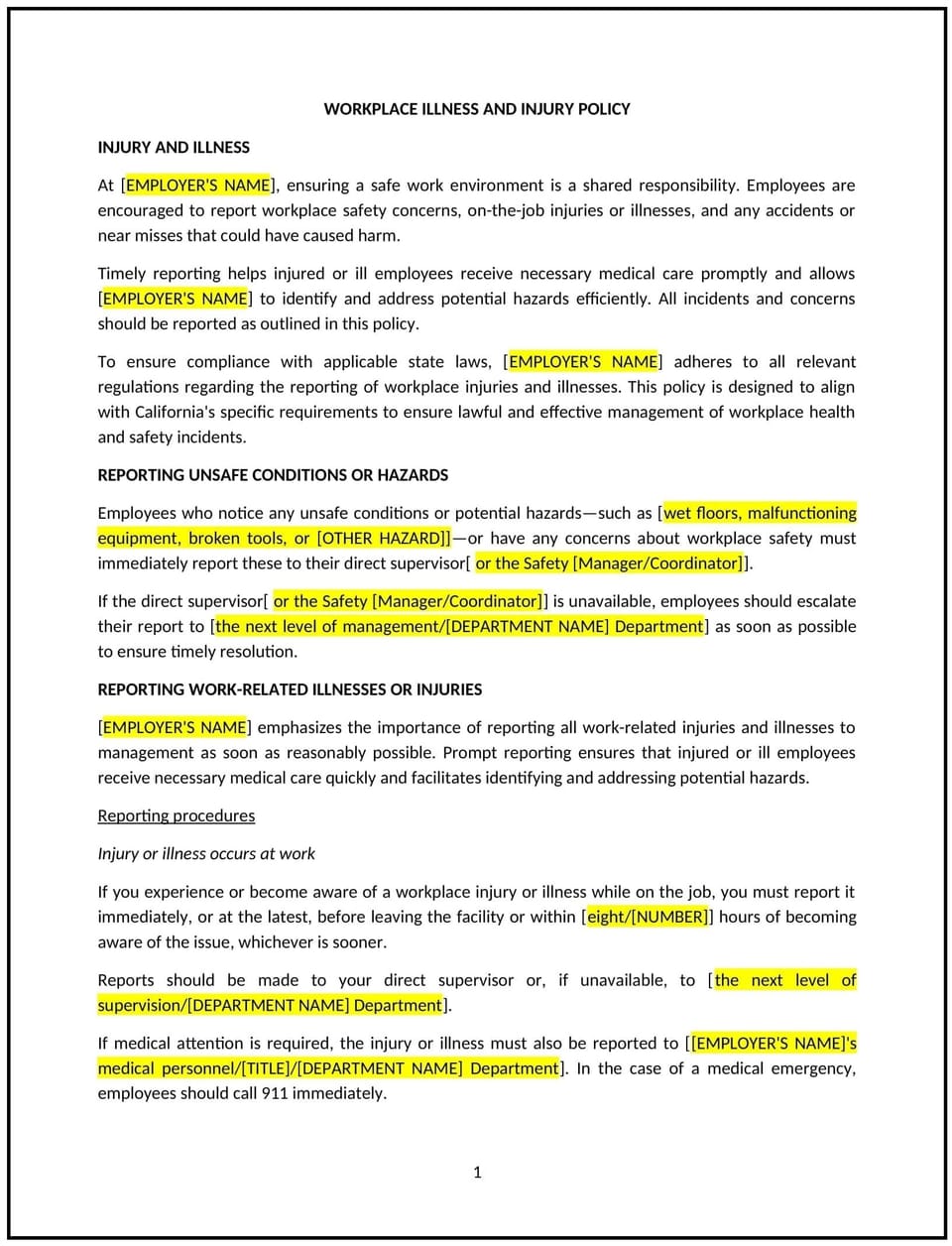Workplace illness and injury policy (California): Free template

Workplace illness and injury policy (California)
In California, a workplace illness and injury policy provides businesses with guidelines to address workplace-related illnesses and injuries, ensuring compliance with state regulations, such as the California Occupational Safety and Health Act (Cal/OSHA). This policy outlines procedures for preventing, reporting, and responding to workplace health and safety incidents.
By implementing this policy, California businesses can prioritize employee well-being, reduce risks, and maintain a safe work environment.
How to use this workplace illness and injury policy (California)
- Define scope: Specify the types of illnesses and injuries covered by the policy, including those related to workplace hazards or conditions.
- Communicate reporting procedures: Provide clear steps for employees to report workplace illnesses or injuries, ensuring timely and accurate documentation.
- Outline response protocols: Detail the process for addressing reported incidents, including medical assistance, investigations, and corrective actions.
- Emphasize prevention: Promote safety training, risk assessments, and adherence to Cal/OSHA regulations to prevent workplace health and safety issues.
- Maintain records: Keep detailed records of reported incidents and related actions to ensure compliance with California laws.
Benefits of using this workplace illness and injury policy (California)
This policy offers several advantages for California businesses:
- Supports compliance: Reflects Cal/OSHA regulations for workplace safety and incident management.
- Enhances safety: Promotes a proactive approach to identifying and mitigating workplace health risks.
- Reduces risks: Minimizes potential legal liabilities and disruptions caused by workplace incidents.
- Improves accountability: Establishes clear responsibilities for employees and management in preventing and addressing workplace health issues.
- Builds trust: Demonstrates the business’s commitment to employee well-being and safety.
Tips for using this workplace illness and injury policy (California)
- Reflect California-specific laws: Ensure compliance with Cal/OSHA standards for reporting, investigation, and prevention of workplace incidents.
- Train employees: Provide regular training on workplace safety practices and reporting procedures.
- Conduct safety audits: Perform routine evaluations of workplace conditions to identify and address potential hazards.
- Use clear communication: Ensure employees understand their responsibilities and the importance of promptly reporting illnesses or injuries.
- Review regularly: Update the policy to reflect changes in California laws, workplace conditions, or best practices.
Q: How does this policy benefit the business?
A: This policy supports compliance with California safety laws, reduces risks, and fosters a safer and healthier workplace.
Q: What illnesses and injuries are covered under this policy?
A: Covered incidents include any workplace-related illnesses or injuries resulting from hazards, conditions, or activities on the job.
Q: How does this policy support compliance with California laws?
A: The policy aligns with Cal/OSHA requirements, ensuring lawful reporting, investigation, and prevention of workplace incidents.
Q: What steps should employees take to report a workplace illness or injury?
A: Employees should notify their manager or HR immediately, complete the necessary documentation, and seek medical attention if needed.
Q: How can the business prevent workplace illnesses and injuries?
A: The business can provide safety training, conduct risk assessments, and enforce safety protocols to minimize hazards.
This article contains general legal information and does not contain legal advice. Cobrief is not a law firm or a substitute for an attorney or law firm. The law is complex and changes often. For legal advice, please ask a lawyer.


